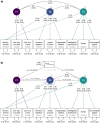This is a preprint.
Preschool musicality is associated with school-age communication abilities through genes related to rhythmicity
- PMID: 39314312
- PMCID: PMC11419103
- DOI: 10.1101/2024.09.09.611603
Preschool musicality is associated with school-age communication abilities through genes related to rhythmicity
Update in
-
Preschool musicality is associated with school-age communication abilities through genes related to rhythmicity.NPJ Sci Learn. 2025 Jun 13;10(1):39. doi: 10.1038/s41539-025-00329-y. NPJ Sci Learn. 2025. PMID: 40514356 Free PMC article.
Abstract
Early-life musical engagement is an understudied but developmentally important and heritable precursor of later (social) communication and language abilities. This study aims to uncover the aetiological mechanisms linking musical to communication abilities. We derived polygenic scores (PGS) for self-reported beat synchronisation abilities (PGSrhythmicity) in children (N≤6,737) from the Avon Longitudinal Study of Parents and Children and tested their association with preschool musical (0.5-5 years) and school-age (social) communication and cognition-related abilities (9-12 years). We further assessed whether relationships between preschool musicality and school-age communication are shared through PGSrhythmicity, using structural equation modelling techniques. PGSrhythmicity were associated with preschool musicality (Nagelkerke-R2=0.70-0.79%), and school-age communication and cognition-related abilities (R2=0.08-0.41%), but not social communication. We identified links between preschool musicality and school-age speech- and syntax-related communication abilities as captured by known genetic influences underlying rhythmicity (shared effect β=0.0065(SE=0.0021), p=0.0016), above and beyond general cognition, strengthening support for early music intervention programmes.
Keywords: beat synchronisation; communication; musical engagement; polygenic scoring analyses; structural equation modelling.
Conflict of interest statement
Competing interests The authors declare no competing interests.
Figures



Similar articles
-
Preschool musicality is associated with school-age communication abilities through genes related to rhythmicity.NPJ Sci Learn. 2025 Jun 13;10(1):39. doi: 10.1038/s41539-025-00329-y. NPJ Sci Learn. 2025. PMID: 40514356 Free PMC article.
-
The Musical Abilities, Pleiotropy, Language, and Environment (MAPLE) Framework for Understanding Musicality-Language Links Across the Lifespan.Neurobiol Lang (Camb). 2022 Dec 16;3(4):615-664. doi: 10.1162/nol_a_00079. eCollection 2022. Neurobiol Lang (Camb). 2022. PMID: 36742012 Free PMC article. Review.
-
Musical instrument engagement in adolescence predicts verbal ability 4 years later: A twin and adoption study.Dev Psychol. 2021 Nov;57(11):1943-1957. doi: 10.1037/dev0001245. Dev Psychol. 2021. PMID: 34914455 Free PMC article.
-
Intergenerational longitudinal associations between parental reading/musical traits, infants' auditory processing, and later phonological awareness skills.Front Neurosci. 2023 Jul 19;17:1201997. doi: 10.3389/fnins.2023.1201997. eCollection 2023. Front Neurosci. 2023. PMID: 37539387 Free PMC article.
-
Human Genomics and the Biocultural Origin of Music.Int J Mol Sci. 2021 May 20;22(10):5397. doi: 10.3390/ijms22105397. Int J Mol Sci. 2021. PMID: 34065521 Free PMC article. Review.
References
-
- Levinson S. C. Interactional Foundations of Language: The Interaction Engine Hypothesis. in Human Language (ed. Hagoort P.) 189–200 (The MIT Press, 2019). doi: 10.7551/mitpress/10841.003.0018. - DOI
-
- ASHA Practice Policy. American Speech-Language-Hearing Association https://www.asha.org/policy.
-
- Social Communication. American Speech-Language-Hearing Association https://www.asha.org/public/speech/development/social-communication/.
Publication types
Grants and funding
LinkOut - more resources
Full Text Sources
